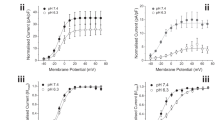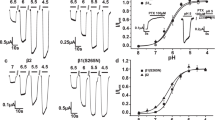Abstract
Synaptic inhibition mediated by γ-aminobutyric acid (GABA) is known to involve opening of receptor-gated chloride channels1–3. Recent evidence indicates that these channels also show a significant permeability to the physiologically important bicarbonate anion4. In all the excitable cells studied to date, the intracellular pH (pHi) is higher than would be predicted from a passive distribution of H+ ions5–9, and consequently there is an outwardly directed electrochemical driving force for HCO3−. In the presence of CO2/HCO3− therefore, activation of GABA-gated channels could give rise to a significant efflux of bicarbonate, leading to a fall in postsynaptic pHi. We have examined the influence of GABA on pHi in crayfish skeletal muscle and we find that in the presence of CO2, GABA induces a dramatic fall in pHi which is coupled to an alkalosis at the extracellular surface. This fall in pHi and the extracellular alkalosis are attributable to a GABA-activated, picrotoxin-sensitive HCO3−-conductance. In view of the sensitivity of ion channels10 and intracellular ion concentrations5–9 to changes in pHi, a GABA-induced postsynaptic acidosis could prove to be important in the modulation of inhibitory transmission.
This is a preview of subscription content, access via your institution
Access options
Subscribe to this journal
Receive 51 print issues and online access
$199.00 per year
only $3.90 per issue
Buy this article
- Purchase on Springer Link
- Instant access to full article PDF
Prices may be subject to local taxes which are calculated during checkout
Similar content being viewed by others
References
1. Krnjevic, K. Physiol. Rev. 54, 418-540 (1974). 2. Siggins, G. R. & Gruol, D. R. in Handbook of Physiology, Section I: The Nervous System Vol. IV, 1-114 (ed. Bloom, F. E.) (American Physiological Society, Bethesda, Maryland, 1986). 3. Takeuchi, A. & Takeuchi, N. J. Physiol., Lond. 191, 575-590 (1967). 4. Bormann, J., Hamill, O. P. & Sakmann, B. J. Physiol., Lond. 385, 243-286 (1987). 5. Thomas, R. C. J. Physiol., Lond. 273, 317-338 (1977). 6. Moody, W. J. /. Physiol., Lond. 316, 293-308 (1981). 7. Moser, H. / Physiol., Lond. 362, 23-38 (1985). 8. Caller, S. & Moser, H. /. Physiol., Lond. 374, 137-151 (1986). 9. Chesler, M. J. Physiol., Lond. 381, 241-261 (1986). 10. Moody, W. J. A Rev. Neurosci. 7, 257-278 (1984). 11. Dudel, J., Finger, W. & Stettmeier, H. Pftiigers Arch. 387, 143-151 (1980). 12. Zacher, J., Zacharova, D. & Hencek, M. Physiol. Bohemoslov. 13, 129-136 (1964). 13. Dudel, J. & Rudel, R. Pftiigers Arch. 308, 291-314 (1969). 14. Dudel, J. Pftiigers Arch. 371, 167-174 (1977). 15. Takeuchi, A. & Takeuchi, N. /. Physiol., Lond. 205, 377-391 (1969). 16. Adrian, R. H., Chandler, W. K. & Hodgkin, A. L. /. Physiol., Lond. 208, 607-644 (1970). 17. Constanti, A. & Smart, T. G. Proc. R. Soc. B 215, 343-364 (1982). 18. Goldman, D. E. /. gen. Physiol. 27, 37-60 (1943). 19. Hodgkin, A. L. & Katz, B. /. Physiol., Lond. 108, 37-77 (1949). 20. Gaillard, S. & Malan, A. Molec. Physiol. 4, 231-243 (1983). 21. Kelly, J. S., Krnjevic, K., Morris, M. E. & Yim, G. K. W. Expl Brain Res. 7, 11-31 (1969). 22. Dudel, J. & Kuffler, S. W. / Physiol., Lond. 155, 514-529 (1961). 23. Kaila, K. & Voipio, J. J. Physiol., Lond. 369, 8P (1985). 24. Kaila, K. & Vaughan-Jones, R. D. J. Physiol., Lond. 390, 93-118 (1987). 25. Vaughan-Jones, R. D. /. Physiol., Lond. 295, 83-109 (1979). 26. Vaughan-Jones, R. D. & Kaila, K. Pfliigers Arch. 406, 641-644 (1986).
Author information
Authors and Affiliations
Rights and permissions
About this article
Cite this article
Kaila, K., Voipio, J. Postsynaptic fall in intracellular pH induced by GABA-activated bicarbonate conductance. Nature 330, 163–165 (1987). https://doi.org/10.1038/330163a0
Received:
Accepted:
Issue Date:
DOI: https://doi.org/10.1038/330163a0
This article is cited by
-
Why won’t it stop? The dynamics of benzodiazepine resistance in status epilepticus
Nature Reviews Neurology (2022)
-
Molecular Mechanisms of Epilepsy: The Role of the Chloride Transporter KCC2
Journal of Molecular Neuroscience (2022)
-
Enhancing neuronal chloride extrusion rescues α2/α3 GABAA-mediated analgesia in neuropathic pain
Nature Communications (2020)
-
Intracellular Chloride Regulation in AVP+ and VIP+ Neurons of the Suprachiasmatic Nucleus
Scientific Reports (2017)
-
Spines slow down dendritic chloride diffusion and affect short-term ionic plasticity of GABAergic inhibition
Scientific Reports (2016)
Comments
By submitting a comment you agree to abide by our Terms and Community Guidelines. If you find something abusive or that does not comply with our terms or guidelines please flag it as inappropriate.



